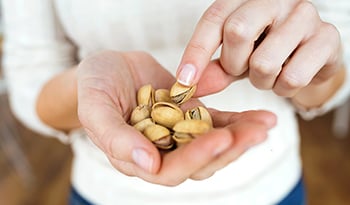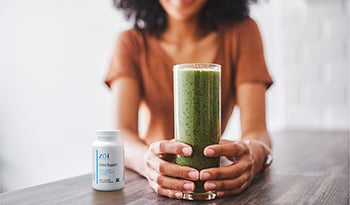The Best Foods and Supplements for Natural Sun Protection
DISCLAIMER:This blog does not intend to provide diagnosis...
- In this article:
- Benefits of Carotene-Rich Foods and Supplements
- Green Drink Benefits
- Pearl Tomato Extract Benefits
- Polypodium Leucotomos Extract Benefits
- Cacao Flavanol Benefits

Originally posted June 2017 / Updated May 2023
A sunburn results from inflammation and skin damage caused by overexposure to ultraviolet (UV) radiation from the sun.
Safe, topical sunscreens are essential for external protection and protect your skin from the inside out.
Here are the best foods and dietary supplements to help protect the body from harm caused by sun exposure.
Benefits of Carotene-Rich Foods and Supplements
The carotenoids (carotenes and xanthophylls) represent the most widespread group of naturally occurring pigments in nature. They are a red to yellow colored group of fat-soluble compounds that function in plants to protect against damage produced during photosynthesis, which converts the sun’s energy into a chemical form.
This process creates a lot of highly reactive compounds; without the carotenoids, the plant would be destroyed in the process.
Over 400 carotenes have been identified, but only about 30 to 50 are referred to as “provitamin A carotenes” because they can be converted in the body to vitamin A.
Historically, the biological effects of carotenes have been based on their corresponding vitamin A activity. Because beta-carotene has a higher provitamin A activity than other carotenes, it has been considered the most active.
However, considerable research shows that many non-vitamin A carotenes, such as lutein, lycopene, and astaxanthin, exhibit far greater biological activity.
Unlike vitamin A, which is stored primarily in the liver, carotenes are mainly stored in the skin, gastrointestinal, respiratory, and urinary tract lining, fat cells, and other organs. Once incorporated into the skin, carotenes offer significant protection against sun damage. Beta-carotene is the standard medical treatment for photosensitivity disorders.
To boost carotene levels through diet, focus on dark green leafy vegetables (kale, collards, and spinach) and yellow-orange fruits and vegetables (apricots, cantaloupe, carrots, sweet potatoes, yams, and squash). Try to get two to three servings daily (1 cup raw, ½ cup cooked, equal a serving).
Regarding supplementation with a carotenoid source, the best option for protection against sun damage may be astaxanthin, the “King of Carotenoids.” Astaxanthin can accumulate in the skin more effectively than other carotenoids to protect the skin against sun damage.
Green Drink Benefits
Another strategy to boost dietary carotene intake is to use “green drinks,” which refers to commercially available products containing dehydrated barley grass, wheat grass, or algae sources such as chlorella or spirulina.
Such products are rehydrated by simply mixing with water or juice. Green drinks are particularly rich in phytochemicals that exert health benefits, including carotenes and natural fat-soluble chlorophyll —the green pigment used in photosynthesis that converts sunlight to chemical energy in plants, algae, and some microorganisms.
Including green drinks and fresh green vegetable juices regularly in the diet is a great way to quickly fortify or supplement your intake of carotenes and other important phytochemicals often lacking in the modern diet.
Pearl Tomato Extract Benefits
Pearl tomato extract is derived from the white heirloom beefsteak tomatoes (Solanum lycopersicum). Pearl tomato extract contains the colorless carotene molecules phytoene and phytofluene that exert significant health benefits, including protection against sun damage.
Phytoene and phytofluene are found in the precursors to all colored carotenes, including lycopene, the red carotene found in red tomatoes. Though colorless, phytoene and phytofluene are more powerful in antioxidant effects than colored carotenes.\
Pearl tomato extract is taken internally, resulting in phytoene and phytofluene being incorporated into cells throughout the body to produce protective effects, including the skin. The bioavailability (absorption) of phytoene and phytofluene is three to five times greater compared to lycopene and β-carotene. Many of the health benefits of tomatoes attributed to lycopene are now thought to be due to phytoene and phytofluene instead.
One of the significant uses of pearl tomato extract is as an internal sunscreen in protecting and repairing the skin from sun damage.
Pearl tomato extract is also helpful in melasma, a condition where brown patches appear on the face due to either sun exposure or hormonal changes during pregnancy.
In melasma pearl, tomato extract can help restore proper pigmentation and improve skin tone, texture, and moisture content to decrease skin dryness and roughness.
Polypodium Leucotomos Extract Benefits
Polypodium leucotomos is a fern native to Central and South America. An antioxidant-rich extract of the plant has been shown to improve skin health and reduce sun damage. The extract works by enhancing the activity of the skin cell’s antioxidant systems, thereby reducing inflammation and damage.
Three clinical trials in healthy adults have shown the extract to be safe and effective in reducing damage from sun exposure at a dosage of 240 mg twice daily. It has also been beneficial in melasma.
Two clinical studies have also shown the beneficial effects of P. leucotomos extract in patients with polymorphic light eruption (PLE), an itchy or burning rash that occurs within hours or up to 3 days after sun exposure that lasts up to two weeks. The two studies with P. leucotomos extract showed most subjects experienced a significant reduction of PLE skin reactions under controlled conditions at dosages ranging from 480 to 1200mg daily.
Cacao Flavanol Benefits
Plant flavonoids are also critical in supporting healthy skin. The flavanols found in cacao and cocoa products are especially beneficial in protecting the skin against sun damage. Numerous experimental studies have shown that flavanol-rich cocoa products protect the skin against sun damage.
In a human study, cocoa flavanol ingestion was shown to be effective after one week of ingesting 4-6 grams daily of a high-flavanol cocoa powder. Oral daily supplementation of 1 gram of a high flavanol cacao was not effective.
References:
- Yamashita E. The Effects of a Dietary Supplement Containing Astaxanthin on Skin Condition. Carotenoid Science. 2006.
- Meléndez-Martínez AJ, Mapelli-Brahm P, Benítez-González A, et al. A comprehensive review on the colorless carotenoids phytoene and phytofluene. Arch Biochem Biophys. 2015;572:188-200.
- Cooperstone JL, Tober KL, Riedl KM, et al. Tomatoes protect against the development of UV-induced keratinocyte carcinoma via metabolomic alterations. Sci Rep. 2017;7(1):5106.
- Aust O, Stahl W, Sies H, Tronnier H, Heinrich U. Supplementation with tomato-based products increases lycopene, phytofluene, and phytoene levels in human serum and protects against UV-light-induced erythema. Int J Vitam Nutr Res. 2005;75(1):54-60.
- El-Haj N, Goldstein N. Sun protection in a pill: the photoprotective properties of Polypodium leucotomos extract. Int J Dermatol. 2014 Jul 11.
- Rodríguez-Yanes E, Juarranz Á, Cuevas J, et al. Polypodium leucotomos decreases UV-induced epidermal cell proliferation and enhances p53 expression and plasma antioxidant capacity in hairless mice. Exp Dermatol. 2012;21:638–640. [PubMed] [Google Scholar]
- Nestor MS, Berman B, Swenson N. Safety and Efficacy of Oral Polypodium leucotomos Extract in Healthy Adult Subjects. J Clin Aesthet Dermatol. 2015 Feb;8(2):19-23.
- Middelkamp-Hup MA, Pathak MA, Parrado C, et al. Oral Polypodium leucotomos extract decreases ultraviolet-induced damage to human skin. J Am Acad Dermatol. 2004;51:910–918.
- Ahmed AM, Lopez I, Perese F, et al. A randomized, double-blinded, placebo-controlled trial of oral Polypodium leucotomos extract as an adjunct to sunscreen in the treatment of melasma. JAMA Dermatol. 2013;149:981–983.
- Tanew A, Radakovic S, Gonzalez S, et al. Oral administration of a hydrophilic extract of Polypodium leucotomos for the prevention of polymorphic light eruption. J Am Acad Dermatol. 2012;66:58–62.
- Caccialanza M, Percivalle S, Piccinno R, et al. The photoprotective activity of oral Polypodium leucotomos extracts in 25 patients with idiopathic photodermatoses. Photodermatol Photoimmunol Photomed. 2007;23:46–47.
- Calzavara-Pinton P, Calzavara-Pinton I, Arisi M, Rossi MT, Scapagnini G, Davinelli S, Venturini M. Cutaneous Photoprotective Activity of a Short-term Ingestion of High-Flavanol Cocoa: A Nutritional Intervention Study. Photochem Photobiol. 2019 Jul;95(4):1029-1034. doi: 10.1111/php.13087. Epub 2019 Mar 19. PMID: 30663066.

 By Dr. Michael Murray, N.D.
By Dr. Michael Murray, N.D. 


